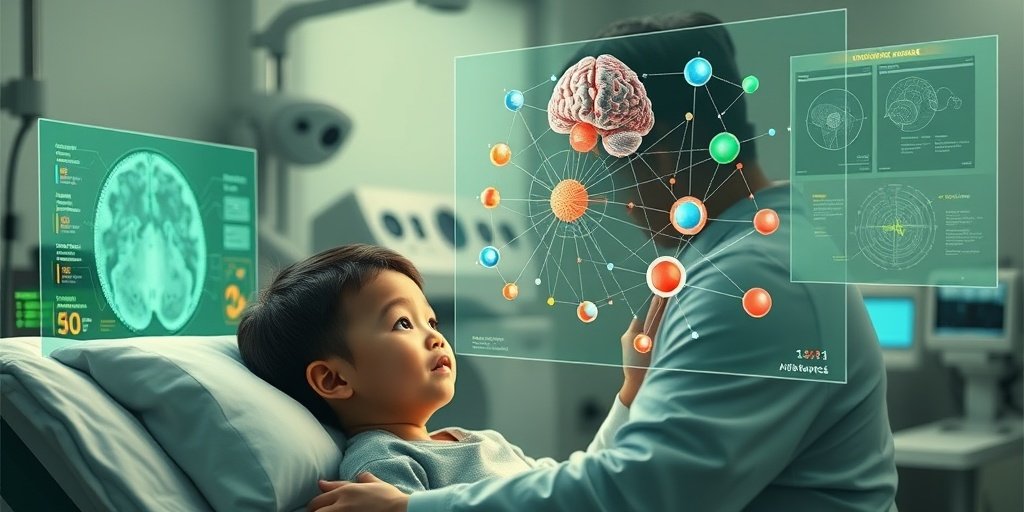⚡ Quick Summary
This study utilized deep learning to uncover critical features in the single-cell transcriptomics of pediatric high-grade gliomas (pHGGs), revealing key determinants of phenotypic plasticity. The findings suggest potential therapeutic strategies aimed at modulating glioma cell fates and overcoming resistance to treatment.
🔍 Key Details
- 📊 Dataset: Single-cell transcriptomics of pediatric high-grade gliomas
- 🧩 Subtypes analyzed: IDHWT glioblastoma and K27M-altered diffuse midline glioma
- ⚙️ Technology: Deep learning and graph-based machine learning
- 🏆 Key genes identified: Transition genes and hub genes associated with glioma plasticity
🔑 Key Takeaways
- 🔬 AI-powered systems are transforming biomarker discovery in cancer research.
- 🌱 Critical determinants of lineage-specific plasticity were identified in pHGGs.
- 🧬 Transition genes such as DKK3 and H3F3A play significant roles in cell fate decisions.
- ⚡ Hub genes like ITM2C and MTRNR2L1 are central regulators of glioma plasticity.
- 🌍 Tumor heterogeneity is linked to stress-response patterns in the tumor microenvironment.
- 🧠 Developmental trajectories favor neocortical cell fates in glioma progression.
- 💡 Precision medicine strategies could help stabilize glioma plasticity and aggressiveness.
- 🔄 Transition therapy toward neuronal-like differentiation is proposed as a potential treatment.

📚 Background
Pediatric high-grade gliomas (pHGGs) are aggressive brain tumors that pose significant challenges in treatment due to their complex biology and heterogeneity. Understanding the underlying mechanisms of phenotypic plasticity in these tumors is crucial for developing effective therapies. Recent advancements in artificial intelligence and machine learning have opened new avenues for biomarker discovery and therapeutic strategies.
🗒️ Study
The study conducted by Uthamacumaran aimed to decode the phenotypic plasticity of pHGGs through deep learning-based feature discovery. By analyzing single-cell transcriptomics data, the researchers identified key genes and network interactions that regulate glioma morphogenesis and response to the tumor-immune microenvironment.
📈 Results
The analysis revealed a spectrum of cellular states navigating a disrupted neuro-differentiation hierarchy. Key transition genes such as DKK3 and H3F3A were identified, along with hub genes like ITM2C and MTRNR2L1, which serve as potential therapeutic targets. The study highlights the maladaptive behaviors and hybrid cellular identities that characterize pHGGs, driven by stress-response patterns to immune-inflammatory microenvironments.
🌍 Impact and Implications
The findings from this study have significant implications for the field of oncology, particularly in the treatment of pediatric brain tumors. By addressing the underlying plasticity networks and identifying therapeutic vulnerabilities, researchers can develop precision medicine strategies that may improve patient outcomes. The proposed transition therapy toward neuronal-like differentiation offers a promising avenue for stabilizing glioma plasticity and reducing tumor aggressiveness.
🔮 Conclusion
This research underscores the transformative potential of deep learning in understanding and treating pediatric high-grade gliomas. By uncovering the complexities of glioma plasticity, we can pave the way for innovative therapeutic approaches that enhance treatment efficacy and patient care. Continued exploration in this area is essential for advancing precision medicine in oncology.
💬 Your comments
What are your thoughts on the role of AI in cancer research? Let’s start a conversation! 💬 Leave your thoughts in the comments below or connect with us on social media:
Deep learning-based feature discovery for decoding phenotypic plasticity in pediatric high-grade gliomas single-cell transcriptomics.
Abstract
Advancements in AI-powered systems medicine have revolutionized biomarker discovery through emergent and explainable features. By use of complex network dynamics and graph-based machine learning, we identified critical determinants of lineage-specific plasticity across the single-cell transcriptomics of pediatric high-grade glioma (pHGGs) subtypes: IDHWT glioblastoma and K27M-altered diffuse midline glioma. Our study identified network interactions regulating glioma morphogenesis via the tumor-immune microenvironment, including neurodevelopmental programs, calcium dynamics, iron metabolism, metabolic reprogramming, and feedback loops between MAPK/ERK and WNT signaling. These relationships highlight the emergence of a hybrid spectrum of cellular states navigating a disrupted neuro-differentiation hierarchy. We identified transition genes such as DKK3, NOTCH2, GATAD1, GFAP, and SEZ6L in IDHWT glioblastoma, and H3F3A, ANXA6, HES6/7, SIRT2, FXYD6, PTPRZ1, MEIS1, CXXC5, KDM4C, and NDUFAB1 in K27M subtypes. We also identified MTRNR2L1, GAPDH, IGF2, FKBP variants, and FXYD7 as transition genes (plasticity signatures) that influence cell fate decision-making across both subsystems. We also discovered hub genes such as ITM2C, NOP16, ACTB in IDHWT, and MTRNR2L1, EEF1A1, RPS3A, and H3F3A in K27M gliomas, which serve as central regulators of glioma plasticity and potential therapeutic targets. Our findings suggest pHGGs are developmentally trapped in states exhibiting maladaptive behaviors, and hybrid cellular identities. In effect, tumor heterogeneity (metastability) and plasticity emerge as stress-response patterns to immune-inflammatory microenvironments and oxidative stress. Furthermore, we show that pHGGs are steered by developmental trajectories from radial glia predominantly favoring neocortical cell fates, in telencephalon and prefrontal cortex (PFC) differentiation. By addressing underlying patterning processes and plasticity networks as therapeutic vulnerabilities, our findings provide precision medicine strategies aimed at modulating glioma cell fates and overcoming therapeutic resistance. We suggest transition therapy toward neuronal-like lineage differentiation as a potential precision therapy to help stabilize pHGG plasticity and aggressivity.
Author: [‘Uthamacumaran A’]
Journal: Comput Biol Med
Citation: Uthamacumaran A. Deep learning-based feature discovery for decoding phenotypic plasticity in pediatric high-grade gliomas single-cell transcriptomics. Deep learning-based feature discovery for decoding phenotypic plasticity in pediatric high-grade gliomas single-cell transcriptomics. 2025; 197:110971. doi: 10.1016/j.compbiomed.2025.110971